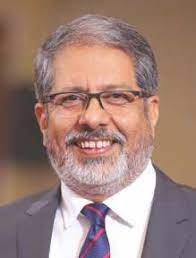Widening of co-lending framework gives wider choices to all parties concerned

FinTech BizNews Service
Mumbai, April 9, 2025: The Monetary Policy Committee (MPC) held its 54th meeting from April 7 to 9, 2025 under the chairmanship of Shri Sanjay Malhotra, Governor, Reserve Bank of India. The MPC members Dr. Nagesh Kumar, Shri Saugata Bhattacharya, Prof. Ram Singh, Dr. Rajiv Ranjan, and Shri M. Rajeshwar Rao attended the meeting.
After assessing the current and evolving macroeconomic situation, the MPC unanimously voted to reduce the policy repo rate by 25 basis points to 6.00 per cent with immediate effect. The real GDP growth for 2025-26 is now projected at 6.5 per cent, with Q1 at 6.5 per cent; Q2 at 6.7 per cent; Q3 at 6.6 per cent; and Q4 at 6.3 per cent. The risks are evenly balanced.
Here are views of leading voices from the banking sector on the MPC decisions:
CS Setty, Chairman, SBI:
“The RBI rate cut coupled with the revision in stance to accommodative was a swift, timely move and a forward guidance to the market to stay supportive against evolving global uncertainties. The revision of stance to accommodation will cushion the secondary impact of tariffs on domestic economy. With inflation under check, growth imperatives will take precedence in FY26.
On the regulation side market-based securitization framework for stressed assets, review of policy on gold lending and non-fund-based facility are timely. Widening of co-lending framework gives wider choices to all parties concerned”

Sarvjit Singh Samra, MD & CEO of Capital Small Finance Bank:
“The RBI’s decision to reduce the repo rate by 25 bps to 6.00% in its first monetary policy of FY25-26, along with a shift in stance to ‘accommodative’ reflects a strong and timely commitment to supporting economic growth. This policy move comes against the backdrop of a strengthening demand recovery and inflation staying firmly aligned with the 4% target reinforced by a consistent easing in food inflation. For the banking sector this marks a significant tailwind, as lower funding costs and improved credit transmission are likely to boost lending activity. For Small Finance Banks, this presents a strong opportunity to scale up lending, backed by rising credit demand and a supportive interest rate environment.
At Capital Small Finance Bank, we see this as a timely catalyst to drive broad-based economic momentum and accelerate credit growth particularly in MSME, Agriculture, and affordable mortgage segments across semi-urban and rural (SURU) regions—furthering our mission of deeper financial penetration and fast paced sustainable growth and expansion.”

Madan Sabnavis, Chief Economist, Bank of Baroda:
Madan Sabnavis, Chief Economist, Bank of Baroda:
RBI has shown inherent confidence in the economy in the midst of the tariff turmoil. While GDP growth has been lowered for the year to 6.5% inflation has also been moderated to 4%. Given the change in stance to accommodative which has been clarified as referring not to liquidity but future rate action we may expect another 25-50 bps cut through the year. A pause in June is possible as monsoon is gauged. We can expect repo at say 5.5% by March.
Pradeep B, Business Head-Housing Loans and Micro Mortgages at Ujjivan Small Finance Bank:
“The RBI’s move signals a pro-growth stance that could immediately ease the burden of floating rate home loan borrowers by enabling banks to pass on the rate cut at the specified reset date. This facilitates the customers either to lower the EMIs or the tenure thereby reducing the financial liability of the customers, and boosts the affordability of the customers. The financial institutions can also leverage this to stimulate the housing loan demand through targeted outreach, especially in the affordable and mid-income segments. Lower borrowing costs may also help lenders strengthen their balance sheets, giving financial institutions headroom to expand credit.”

Indranil Pan, Chief Economist at YES BANK:
Indranil Pan, Chief Economist at YES BANK:
The RBI has delivered what the market expected – a 25-bps cut and a change in stance to “accommodative”. It was also explained that being “accommodative” means that there would be no chance of a rate hike at this point, even as the RBI stays vigilant with the evolving macro scenario of tariff wars and geopolitical risks. Both inflation and growth forecasts were lowered by 20 bps. There were no fresh liquidity measures that were announced in this policy. The space for policy rate cuts were predicated by a decisive change in the inflation outlook, led by food prices and more specifically vegetable prices. Given projections by the Skymet of a normal monsoon, the risks to food inflation is likely reduced. At the other end of the spectrum, global growth risks have unleashed a sharp softening in crude oil and other commodity prices, and this is also a positive for India’s inflation dynamics. Overall, the confidence that inflation would remain aligned to the 4% target has magnified. Given a 4% inflation target, the scope of pushing repo rate down to 5.50% in this cycle has opened. Consequently, we expect the RBI to cut in June and also in August.

Siddhartha Sanyal, Chief Economist & Head Research, Bandhan Bank
Siddhartha Sanyal, Chief Economist & Head Research, Bandhan Bank:
“RBI’s cutting the repo rate today was on the expected line. The change in stance to accommodative and overall dovish tone sends a clear signal that RBI has adopted a growth-supportive stand amid rising global uncertainties.
RBI has cut down both its GDP and inflation forecast for FY26 by around 20 bps, further reinforcing the need and space for monetary easing.
Governor’s explicit emphasis on keeping liquidity at “sufficient” surplus at around 1% NDTL clearly underscores the central bank’s commitment for proactive liquidity management.
While one remains watchful of global growth concerns, and global volatility including volatile cross-currency movements, the baseline expectation is that of at least another 50 bps repo rate cut by RBI during FY26, potentially in a front-loaded fashion.”